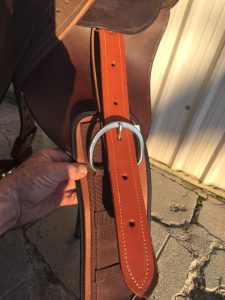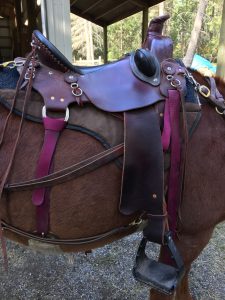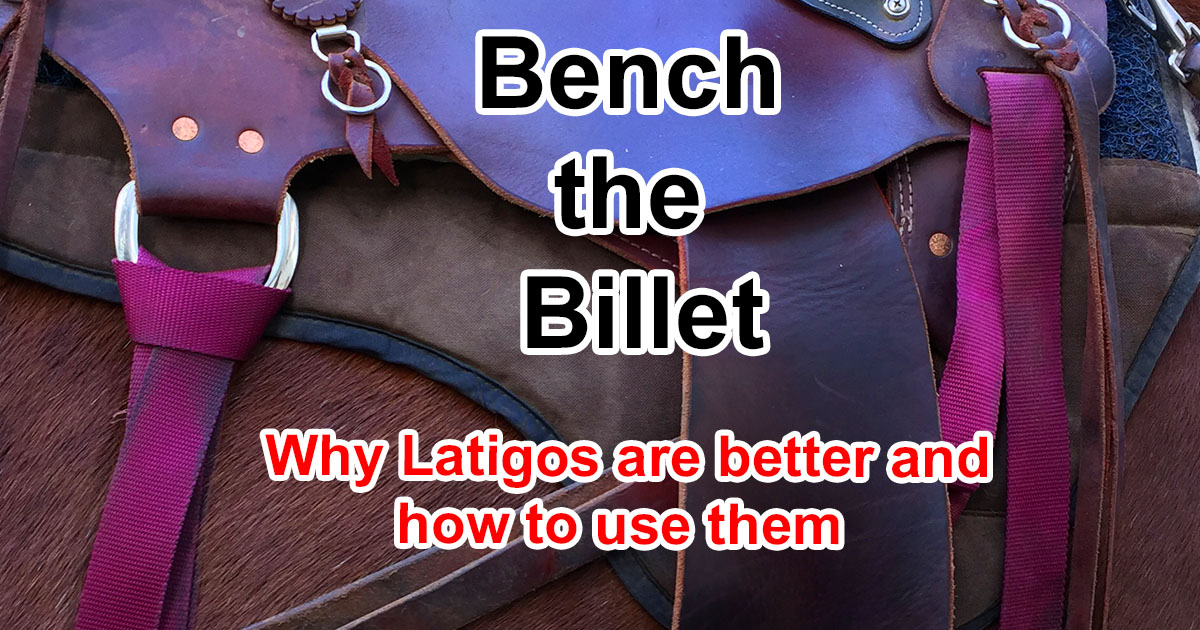Bench the Billets: Why Latigo is a better option – latigo vs billets
I get a lot of questions about why I don’t use off billets, preferring instead to hang latigo straps on all four corners of my saddle. Here’s why I like latigo vs billets and how I use them.
In the latigo vs billets debate I think first of the practicalities of the matter with “tradition” coming in a distant second. For me the more pragmatic questions include what is easier on my animals and what is better to hold the saddle in place.
 In a traditional saddle rigging arrangement the offside of the saddle has a leather billet of approximately 2 inches by 21 inches perforated with 6-8 holes to accommodate a cinch buckle. Most adjustment to the cinch is done from the near side of the saddle via the latigo strap.
In a traditional saddle rigging arrangement the offside of the saddle has a leather billet of approximately 2 inches by 21 inches perforated with 6-8 holes to accommodate a cinch buckle. Most adjustment to the cinch is done from the near side of the saddle via the latigo strap.
A far better arrangement is having latigos on both sides of the saddle and forgoing the billet entirely. Having dual latigo allows the rider to better keep the cinch centered when adjusting and that makes for a more comfortable animal. My mules don’t get to choose when they go out. I feel that it’s my responsibility, as good employer, to ensure that they have the best working conditions as I can possibly create for them. By removing the billet with only 6-8 adjustment positions and replacing it with an infinitely adjustable latigo arrangement I can better fulfill this commitment to them.
 Latigos on each side provide me with the ability to tighten a cinch from either side of the animal, an important consideration on narrow mountain trails. Additionally, a centered cinch provides more even tension on the saddle and helps keep the breast collar in place without rubbing.
Latigos on each side provide me with the ability to tighten a cinch from either side of the animal, an important consideration on narrow mountain trails. Additionally, a centered cinch provides more even tension on the saddle and helps keep the breast collar in place without rubbing.
I can take this comfort principle another step by using a back cinch with the same double latigo setup.
An actual quote from a well-known “clinician”. “If your horse has good withers, you won’t have to over-tighten; if he has poor withers, he’ll have to get used to a much tighter cinch.” What about my mules? Are they doomed to a too tight cinch?
Dual Cinches
Like most people, I used to use a single cinch. I’d reef on it before heading out and then retighten periodically as I made my way down the trail as it loosened. I also used to complain about my animal’s “blowing up”. Sucking air in and holding it to keep me from tightening the cinch. Instead of grumbling I should have asked why they were doing this and how I could better address the situation. In hindsight it’s pretty obvious. The horse was holding its breathe to keep me from overtightening the cinch and causing him pain. If my belt is too tight I’m not going to be comfortable nor happy either. Using two “belts” with my critters lets me keep them a bit looser and more comfy for the beasts.
I’ve found that by using those rear dees that nearly every saddle has, I don’t have to tighten the cinches nearly as much as what I once did. Secondly. I don’t have to stop on the trail to retighten them as often as I used to. And furthermore my saddle stays in place much better when I’m using a rear cinch.
It doesn’t hurt at all that with both cinches in play I can catch my mules bellies and keep the saddle from moving fore or aft as well. Since I switched to latigos and started using a rear cinch I haven’t had any issues with blowing up or breath holding. Cinchy-ness is no longer a thing.
A note on rear cinches:
When you use a rear cinch you should have a cinch hobble (strap) attached to both the front and rear cinches to prevent the back cinch from sliding backwards to the animal’s flank. This prevents your trail ride from becoming a rodeo. A rear cinch that is too loose is also an accident waiting to happen. I have seen hind legs get caught up in loose back cinches. Those rides didn’t end well. These are easily avoided problems. Take the time to cinch up properly.
Use a latigo instead of that worn out billet strap. While you’re at it put those rear dees to use. You’ll be glad you did.
For more practical information for trail rides and horse campers visit us at www.TrailMeister.com.
latigo vs billets


